
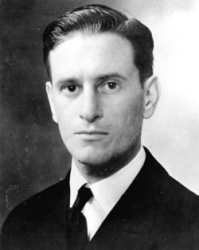 |
|
|
||
|
EUGENE ELBERT LINDSEY 'Gene' |
||||
|
Graduate, U.S. Naval Academy, Class of 1927 Engagements: • World War II (1941 - 1945) |
||||
| Biography: | ||||
|
Eugene Elbert Lindsey Lieutenant Commander, United States Navy Navy Cross Elbert P Lindsey and Delia Zoe Ayotte, who had previously been married to Francis B. Cornell, were married in New Westminster, British Columbia, Canada on 22 July 1904. They were the parents of two children, Eugene Elbert “Gene” and Dixie Delbert Lindsey Lashell. Gene Lindsey married Martha Fronk, daughter of Navy Capt and surgeon Clarence Elmer and Laura T. Douglas Fronk. After her husband's death at Midway, Martha married Capt. Elton Watters Grenfell, a submarine officer, on 15 March 1944 in her parent's home in Honolulu, Hawaii. They were the parents of five children. Capt. Grenfell was the recipient of the Navy Cross and Silver Star medals. He was promoted over time to Vice Admiral. Gene graduated from Ft Smith High School, Ft. Smith, Arkansas in June 1923. Along with two fellow Ft. Smith High School classmates, Gene passed the Naval Academy entrance exam and several months later on 8 Sept 1923 he entered the US Naval Academy (USNA) in Annapolis, MD via a Congressional Appointment from Arkansas. While at the USNA he was fully engaged in athletics. He participated in Track, Cross Country, Swimming, and Gymnasium. He was also involved with Class Numerals, Navy Numerals, Gymkhana: cast and manager Roustabouts. It was written in the 1927 Lucky Bag yearbook about "Eel" and "Gene" as he was sometimes called, "Eel was born in the state of Washington, but early decided the weather was too balmy and went South. Splitting up his time in grade school and high school between Arkansas, Kansas and Texas, Eel graduated in '22, but was a bear for punishment, and came back and graduated from Fort Smith High again in '23, thus having attended six high schools. He ever had that wanderlust fever and regularly went on barnstorming expeditions, running off with the natives' first money for track and diving honors. This is probably what caused him to choose a life on the sea. It was late in Plebe summer before he arrived. But he states this was an advantage, because he wasn't supposed to know as much as the rest. Eel was soon on the list of track and gym athletes, never satisfied unless trying something new. This was especially true of him on the flying rings or on the diving board. Second class year he had a regular gym class, and it was probably due to his work that some men were not permanent fixtures of the weak-squad. His brow is unfurrowed from worry over academics. He said they may get him down, but they couldn't get him out. "This lesson looks hard. I'm going over to the hospital for the morning." Gene graduated on 2 Jun 1927 and received a commission in the United States Navy as an Ensign. Ensign Lindsey, after graduation, was soon off to his mandatory sea duty tour. He reported on board the newly constructed aircraft carrier USS Saratoga (CV-3) about September 1927. She was commissioned on 16 Nov 1927 and was assigned to the Pacific Fleet (I can find no record that he was assigned to the USS Nevada (BB-36) during his active service in the US Navy.) He completed his tour on board Saratoga in Dec 1928 when he transferred to the Naval Air Station, Pensacola, FL to begin pilot training. He completed his pilot training by December 1929* when he detached from NAS Pensacola on 21 Dec 1929 to report to Aircraft Squadrons, Battle Fleet, where he was assigned in a flight status to Bombing Squadron 1B (VB-1b). It was during this tour that Ens. Lindsey completed a Naval War College Correspondence Course on Strategy and Tactics. *Of note, in the Navy/Marine Corps Officers Register dated 01 Jan 1930 Ensign Lindsey was not recorded as being a naval aviator. It wasn’t until the subsequent Register, dated 01 Jan 1931, that the now Ltjg Lindsey, was credited with his naval aviator designation in the record. It may be that he earned his pilot qualifications too late in the year of 1929 to be included in the register dated 01 Jan 1930. During his tour with VB-1b, Ensign Lindsey was promoted to Lieutenant Junior Grade (Ltjg) on 02 June 1930. Following his assignment with VB-1b, Ltjg Lindsey was assigned to the aircraft carrier USS Lexington (CV-2) until May 1933. On 24 Jun 1933, Ltjg Lindsey reported to Aircraft Squadrons, Pearl Harbor, and Patrol Squadron Six “F” (VP-6-F). It was during this tour that he met his future wife, Martha Fronk. In addition, during this tour, he completed a Naval War College Correspondence Course in International Law. On 23 April 1935, Ltjg Lindsey and Martha Helen Fronk were married in St. Andrew's Cathedral in Honolulu, Hawaii. Several months later, 26 Jun 1935, he was assigned as a student at the Navy Post Graduate School in Annapolis, MD to study Aeronautical Engineering. Gene and Martha set up housekeeping in Annapolis. Six months later, Gene’s first child, a son, Eugene Elbert Jr, was born. The following year, 30 Jun 1936, Ltjg Lindsey was promoted to the rank of Lieutenant. Subsequent to his Academy tour, Lt Lindsey was sent to the University of Michigan, Ann Arbor, as a student where he completed a postgraduate course in Aeronautical Engineering. After his work at Ann Arbor was completed, Lt Lindsey was assigned in a flight status to Observation Squadron Four, attached to the Colorado Class battleship, USS Maryland (BB-46) on 01 July 1938. It was during this tour of duty that Gene's second child, Mary Louise Lindsey, was born on 29 May 1939 in Long Beach, CA. His final assignment was as the Commanding Officer, Torpedo Squadron Six (VT-6), attached to the aircraft carrier USS Enterprise (CV-6). He assumed command on 03 Jun 1940. He was promoted to Lieutenant Commander (Lcdr.) on 01 Nov 1941. The Enterprise was commissioned on 12 May 1938. VT-6 was commissioned on 01 July 1938. During 1939, Enterprise and her embarked squadrons conducted shake down cruises and workup exercises at various times. While the ship was inport the squadrons were temporarily based ashore at their assigned airfields. In Sep 1939, Enterprise became part of the Hawaiian Detachment of the U.S. Fleet whose homeport was Pearl Harbor. In Jan 1940 Enterprise was engaged in exercises in Hawaiian waters. In early Feb, she steamed for Puget Sound Navy Shipyard for an overhaul after making a brief port call in San Diego. In late May, Enterprise, her overhaul completed, returned to San Diego for about a month. She returned to Pearl Harbor on 2 July 1940. Enterprise conducted exercises from August to early Nov in the Hawaiian area. Then on 09 Nov she steamed to San Diego until 2 Dec when she got underway for the Puget Sound Navy Shipyard in Bremerton, WA. Enterprise returned to Pearl Harbor on 21 Jan 1941. During 1941 Enterprise made 13 round trips between Hawaii and San Diego from April - Nov conducting exercise cycles and squadron work-ups. During those months she also shuttled Army Air Force P-39s and P-40s, as well as, Navy aircraft from US West Coast ports to Pearl Harbor and beyond. On 28 Nov 1941, Enterprise, now operating in a war-time steaming condition, left San Diego with a cargo of Marine Fighting Squadron 211 (VMF-211) aircraft and pilots destined for Wake Island. The Marine pilots and their planes flew from Enterprise to Wake Island on 02 Dec 1941. Enterprise was scheduled to arrive back in Pearl Harbor on 06 Dec, but was delayed due to inclement weather. Fortunately, she wasn't inport on the morning of 07 Dec, but arrived later that evening. In the first five months of 1942, Enterprise and her Air Group participated in the Gilbert, Marshall Islands and Wake Island operations in Feb 1942. According to a Report After Battle narrative submitted by VT-6 on 2 Feb 1942, Lcdr Lindsey, flying aircraft 6-T-1, and ACRM Grenat as his gunner, along with eight other torpedo bombers in division one, each carrying 3-500 lb bombs, launched at 0510 on 01 Feb 1942 to attack combatant ships, and shore facilities on Kwajalein Island by horizontal bombing profiles. After returning to Enterprise, these nine aircraft launched again about 0935 to attack the air field and surface ships at Wotje Island and Atoll. During both attacks VT-6 bombers were met with intense anti-aircraft fire from numerous locations. Lcdr Lindsey received the Distinguished Flying Cross for his heroic action against enemy forces. In March, Enterprise attacked enemy installations on Wake and Marcus Islands, and in April, she supported the Doolittle raid. In early May Enterprise and Hornet were sent to the South Pacific to assist USS Lexington and USS Yorktown engaged in the battle of the Coral Sea. The battle was over before they arrived on-scene. After additional operations in the Central Pacific, Enterprise returned to Pearl Harbor on 26 May and began intensive preparations to meet an expected Japanese thrust at Midway Island. On 28 May, Enterprise and Hornet sortied from Pearl Harbor and steamed toward a point Northeast of Midway called "Point Luck." USS Yorktown (CV-5) departed a short time later. After the carriers cleared Peal Harbor their squadrons began flying on board from several Naval Air Stations around Pearl Harbor. It was during this sortie that Lcdr Lindsey's plane hit the round down while attempting to land on Enterprise. The aircraft went over the side. Lindsey and his two crewmen were picked up by the plane guard destroyer USS Monaghan. The crewmen were ok, however, Lindsey was badly injured and confined to sick bay. Doctors feared he might have broken his back. Early in the morning of 4 Jun, after almost a week of recuperation, Lindsey was still so bruised about the face that he could not put on his flight goggles. When asked by the Air Group Commander, Lcdr. Wade McClusky, if he could fly Lindsey answered, “This is what I’ve been trained for, and I will take my squadron in.” A few hours later, aircraft from the USS Enterprise's air group launched to attack the Japanese carrier striking force that was approaching the Midway atoll. Separated from their combat air protection, the torpedo bombers of VT-6, led by Lcdr Gene Lindsey, had to thread their way through a gauntlet of swarming enemy fighters and a hail of anti-aircraft fire. Of the fourteen torpedo planes that took off from the Enterprise that morning only four returned to Enterprise. Lcdr Eugene Elbert Lindsey and his gunner/radioman ACRM Charles Tilden Grenat (not Grant), did not return from this mission. They were listed as missing in action on 04 Jun 1942. Their remains were unrecoverable. On 5 Jun 1943 they were "presumed" dead. Lcdr Lindsey was awarded (Posthumously) the Navy Cross, the Purple Heart, and the Presidential Unit Citation, American Defense Service Medal, American Campaign Medal, Asiatic-Pacific Campaign Medal with one bronze battle star and the World War II Victory Medal. He had previously been awarded two Distinguished Flying Cross medals. Of the 14 Torpedo Bombers from VT-6 that flew against the Japanese on 4 Jan 1942 only four returned to Enterprise. Machinist Albert Walter Winchell (NAP), and his gunner, Aviation Radioman 3rd Class Douglas M. Cossitt, made a water landing before sighting Enterprise. They survived 17 days on the open seas in a rubber raft before being rescued by a Patrol Squadron 24 PBY on 21 Jun 1942, some 360 miles northward of Midway. In all, five VT-6 crews survived the morning attack. ---------------------------------------------------- Those other pilots and crew of VT-6 that were killed in action on 04 June 1942: 1) Lcdr Eugene Elbert Lindsey (VT-6 CO) and his gunner ACRM Charles Tilden Grenat 2) Lt Arthur Vincent Ely (VT-6 XO) and his gunner, RM3Arthur Richard Lindgren 3) Lt Paul James Riley and his gunner, ARM2 Edwin John Mushinski 4) Ltjg John Thomas Eversole and his gunner, RM2 John Udell Lane 5) Ltjg Severin Louis Rombach and his gunner, ARM2 Wilburn Forrest Glenn 6) Ltjg Lloyd Thomas and his gunner, ARM2 Harold Francis Littlefield 7) Ensign Randolph Mitchell Holder and his gunner, ARM3 Gregory Joseph Durawa 8) Ensign John Wiley Brock and his gunner, ARM3 John Melville Blundell 9) Ensign Flourenoy Glenn Hodges and his gunner, RM2 John Hail Bates --------------------------------------------- Combat Action Ribbon (CR) note: None of the Navy/Marine flight crews in the Battle of Midway were eligible for or were awarded the Combat Action Ribbon (CR). See Navy and Marine Corps Awards Manual (SECNAVINST M-1650.1 of 16 Aug 2019, Appendix 2C.1.c (3) Amplifying Guidance). It reads in part, “The CR will not be awarded in connection with aerial flight, . . . “ The CR was established in 1969 and made retroactive to 07 Dec 1941. ------------------------------------------------ Navy Cross Citation reads: The President of the United States of America takes pride in presenting the Navy Cross (Posthumously) to Lieutenant Commander Eugene Elbert Lindsey, United States Navy, for extraordinary heroism and courageous devotion to duty while piloting an airplane of Torpedo Squadron Six in action against enemy Japanese forces in the Battle of Midway on 04 Jun 1942. Participating in a vigorous and intense assault against the Japanese invasion fleet, Lieutenant Commander Lindsey pressed home his attack with relentless determination, in the face of a terrific barrage of anti-aircraft fire. The unprecedented conditions under which his squadron launched its offensive were so exceptional that it is highly improbably the occasion may ever recur where other pilots of the service will be called upon to demonstrate an equal degree of gallantry and fortitude. His extreme disregard of personal safety contributed materially to the success of our forces and his loyal conduct was in keeping with the highest traditions of the United States Naval Service. General Orders: Bureau of Naval Personnel Information Bulletin No. 309 (December 1942) -------------------------------------------- He was awarded two Distinguished Flying Cross medals. Lieutenant Commander Eugene Elbert Lindsey, United States Navy, was awarded the Distinguished Flying Cross for extraordinary achievement while participating in aerial flight during World War II during the Marshall Island attacks. Later, he was awarded a Gold Star in lieu of a Second Award of the Distinguished Flying Cross for extraordinary achievement while participating in aerial flight -------------------------------------- USS Enterprise (CV-6) Presidential Unit Citation: For consistently outstanding performance and distinguished achievement during repeated action against enemy Japanese forces in the Pacific war area, 7 December 1941, to 15 November 1942. Participating in nearly every major carrier engagement in the first year of the war, the Enterprise and her air group, exclusive of far-flung destruction of hostile shore installations throughout the battle area, did sink or damage on her own a total of 35 Japanese vessels and shot down a total of 185 Japanese aircraft. Her aggressive spirit and superb combat efficiency are fitting tribute to the officers and men who so gallantly established her as an ahead bulwark in the defense of the American nation. ------------------------------------ Presidential Commemoration. His family also received a commemoration from President Franklin D. Roosevelt. It reads: In grateful memory of Eugene Elbert Lindsey, who died in the service of his country, SEA, Pacific Area, ATTACHED U.S.S. ENTERPRISE, 5 JUNE 1943 (Presumed)*. He stands in the unbroken line of patriots who have dared to die that freedom might live and grow and increase its blessings. Freedom lives, and through it, he lives -- in a way that humbles the undertakings of most men. (Signed) Franklin D. Roosevelt, President of the United States of America (*Presumed dead on 5 Jun 1943. Actual date gone missing was 4 Jun 1942.) -------------------------------------- Task Force 16 Citation Recognizing its contribution to the Doolittle Raid, 18 April 1942 On the occasion of the 50th anniversary of the Second World War, it is appropriate that we take time to reflect on the unique and daring accomplishments achieved early in the war by Task Force 16. Sailing westward under sealed orders in April 1942, only four months after the devastating raid on Pearl Harbor, Task Force 16, carrying sixteen Army B-25 bombers, proceeded into history. Facing adverse weather and under constant threat of discovery before bombers could be launched to strike the Japanese homeland, the crews of the ships and LTC Doolittle's bombers persevered. On 18 April 1942 at 14:45, perseverance produced success as radio broadcasts from Japan confirmed the success of the raids. These raids were an enormous boost to the morale of the American people in those early and dark days of the war and a harbinger of the future for the Japanese High Command that had so foolishly awakened "The Sleeping Giant." These exploits, which so inspired the service men and women and the nation live on today and are remembered when the necessity of success against all odds is required. (Signed) John H.Dalton Secretary of the Navy 15 May 1995 -------------------------------------------- The USS Lindsey (DD-771), a Sumner class destroyer, was named in his honor. She was launched on 5 March 1944 and commissioned 20 Aug 1944 at Bethlehem Steel Co., San Pedro, CA. Her sponsor was Mrs. Eugene E. Lindsey, widow of Lcdr Lindsey. She was reclassified as a Robert H. Smith-class destroyer Minelayer DM-32 19 July 1944. USS Lindsey arrived in the Pacific on 3 Feb 1945. Operating off Iowa Jima 17 to 19 Feb, Lindsey provided counter battery fire support knocking out six enemy guns ashore. She also provided covering fire for minesweepers that cleared the harbor. The following month Lindsey arrived off Okinawa on 24 March 1945 and swept the harbor for mines in support of inbound transports. She also provided gunfire support for the Marines ashore. On the afternoon of 12 April 1945, Lindsey experienced a Kamikaze attack. During the attack, several "Val" dive-bombers struck the ship. An explosion from the second Japanese plane ripped some 60 feet off her bow. Only expert seamanship by Lindsey's CO kept her from being sunk. After receiving temporary battle damage repair, Lindsey set sail under her own power on 8 July for the east coast via Pearl Harbor and the Panama Canal, arriving in Norfolk, VA 19 Aug 1945. After extensive repairs at the Norfolk Naval Shipyard, Lindsey steamed 6 March 1946 for Charleston, S.C., and arrived the next day. Lindsey decommissioned 23 May 1946 and entered the Atlantic Reserve Fleet. She was berthed at Philadelphia into 1969. She was struck from the Naval Vessel Register on 01 Oct 1970. Sunk as a target off Virginia 09 May 1972. USS Lindsey received two battle stars for World War II ----------------------------------------- [Bio compiled by GML470] |
||||
| Honoree ID: 2768 | Created by: MHOH | |||
Ribbons
Medals
Badges
Honoree Photos
 | 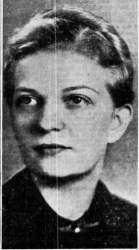 |  |
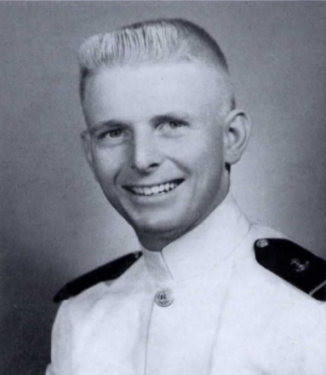 | 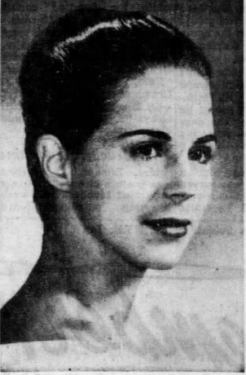 |
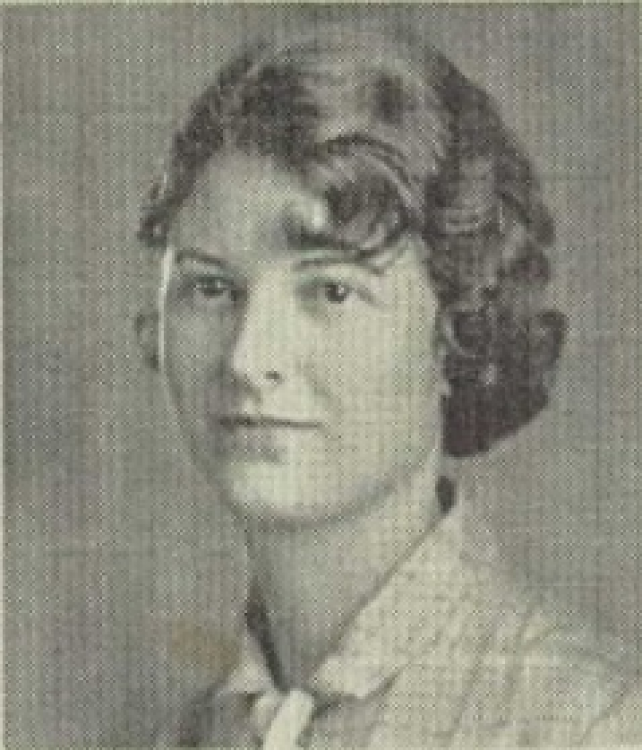 |


